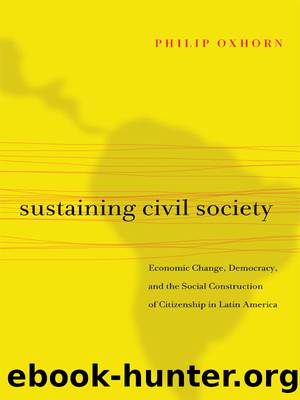sustaining civil society by Philip Oxhorn

Author:Philip Oxhorn [Philip Oxhorn]
Language: eng
Format: epub
ISBN: 978-0-271-04894-9
Publisher: The Pennsylvania State University Press
The Popular Participation Law: An Attempt at Revolution from Above
By any measure, the changes ushered in by the LPP were monumental (see table 5.1). They were a unique combination of state decentralization and participa-tory democracy designed to address problems of institutional development, rent seeking, and national integration from the bottom up. With the LPP, the entire country was placed under the jurisdiction of 311 municipal governments, including 187 new municipal governments covering almost two-thirds of the nationâs territory.9 These municipal governments would now have responsibility for administering health care, education, and infrastructure services, as well as other areas of social investment. To cover these new responsibilities, a new revenue-sharing scheme, coparticipación, was instituted. The state would double the percentage of its revenues that it shared with municipal governments to 20 percent, and distribution would be exclusively on a per capita basis. The result was a windfall for the new city governments and many of the old ones as well. Prior to the change, only 61 city governments received state revenue sharing, and 90 percent went to the three largest citiesâLa Paz, Santa Cruz, and Cochabamba. Now, half of the funds went to rural districts. The municipal governmentsâ share of public investment rose from 11 percent to 39 percent, total social investment doubled, and investment in education tripled. Municipal governments administered almost $3 billion, involving more than seventy thousand projects over ten years, contributing directly to the reduction of poverty from 70.9 percent in 1992 to 58.3 percent in 2003 (Aliendre España 2004, 53).
This dramatic decentralization was accompanied by an innovative scheme for democratizing local governments. Each municipal government would be governed by a popularly elected city council and mayor. CVs were created to serve as the principal link between local government and the literally tens of thousands of OTBs that would now be legally recognized. The OTBs, which in rural areas included traditional indigenous governing organizations, were considered the authentic representatives of the interests of Bolivian civil society, and they would elect the members of the CVs to articulate and represent their priorities in new participatory planning processes to be carried out in each municipal jurisdiction. The CVs would also serve as a mechanism for exercising social control over the portion of municipal budgets financed through coparticipación.
From the perspective of the social construction of citizenship, the LPP epitomized an attempt to institutionalize state-society synergy based on a model of citizenship as agency. The reform explicitly sought to ensure government accountability and transparency by creating a hybrid form of democracy, incorporating Western traditions of representative democracy with local, indigenous traditions of community self-governmentââindividual liberty and a communitarian symbiosisâ (SecretarÃa Nacional 1997, 10). The LPPâs goal, according to then vice president VÃctor Hugo Cárdenasâone of the most prominent political leaders of indigenous descent in Latin America at the timeâwas âmunicipal governance without homogenizing social representationâ (24). In contrast to past state policies of social integration that were seen as overly Westernizing, integration would now be achieved by accepting difference (Arias and Molina 1997).
Download
This site does not store any files on its server. We only index and link to content provided by other sites. Please contact the content providers to delete copyright contents if any and email us, we'll remove relevant links or contents immediately.
The Secret History by Donna Tartt(18857)
The Social Justice Warrior Handbook by Lisa De Pasquale(12143)
Thirteen Reasons Why by Jay Asher(8800)
This Is How You Lose Her by Junot Diaz(6800)
Weapons of Math Destruction by Cathy O'Neil(6151)
Zero to One by Peter Thiel(5691)
Beartown by Fredrik Backman(5603)
The Myth of the Strong Leader by Archie Brown(5429)
The Fire Next Time by James Baldwin(5251)
How Democracies Die by Steven Levitsky & Daniel Ziblatt(5133)
Promise Me, Dad by Joe Biden(5088)
Stone's Rules by Roger Stone(5027)
A Higher Loyalty: Truth, Lies, and Leadership by James Comey(4851)
100 Deadly Skills by Clint Emerson(4845)
Rise and Kill First by Ronen Bergman(4705)
Secrecy World by Jake Bernstein(4652)
The David Icke Guide to the Global Conspiracy (and how to end it) by David Icke(4629)
The Farm by Tom Rob Smith(4442)
The Doomsday Machine by Daniel Ellsberg(4420)
